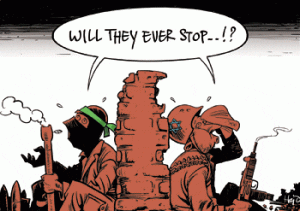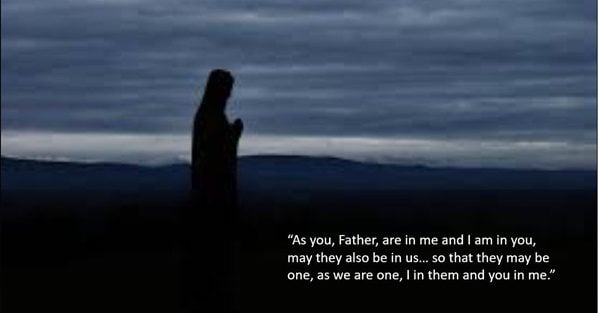 Sometimes a blog just writes itself. I’m preparing to attend the annual academic conference on mimetic theory being held near Munich, Germany July 21-24, 2014. We will be focusing on René Girard’s book on war called Battling to the End in the context of the 100th anniversary of the beginning of World War I. Girard’s analysis of war centers on his reading of another famous treatise written in the aftermath of the Napoleonic wars by Carl von Clausewitz, called simply On War. Needless to say, theories of war are on my mind.
Sometimes a blog just writes itself. I’m preparing to attend the annual academic conference on mimetic theory being held near Munich, Germany July 21-24, 2014. We will be focusing on René Girard’s book on war called Battling to the End in the context of the 100th anniversary of the beginning of World War I. Girard’s analysis of war centers on his reading of another famous treatise written in the aftermath of the Napoleonic wars by Carl von Clausewitz, called simply On War. Needless to say, theories of war are on my mind.
So when I read an article in the New York Times on July 4, America’s Independence Day, I was struck by the way in which it supplied evidence for Girard’s thesis. The article is about the escalating conflict in Israel/ Palestine triggered by the kidnapping and murder of three Israeli youths. This was followed by the kidnapping and murder of a Palestinian youth and an increase in rocket fire from Gaza into Israel and a massing of Israeli troops on the Gaza border. I’ll set quotes from Battling to the End alongside excerpts from this article to illustrate the connection between current events and Girard’s ideas.
The Trend to Extremes
From the news article, commenting on the tit for tat exchange of kidnapping and murder:
“It could be a shift in the nature of the conflict, from political struggle to blood feud,” said Moshe Halbertal, a professor of philosophy at Hebrew University. “It’s no more the Palestinian possible state vis-à-vis the Israeli state; it’s kind of two people entangled in cycles of vengeance.”
From Girard:
Heraclitus wrote that Polemos, war, “is father of all and king of all”… This law of human relations was reformulated [by Clausewitz and] took the shape of the trend to extremes, the inability of politics to contain reciprocal, in other words, mimetic, increase of violence.
Are we witnessing an escalation to extremes? Is violence in Israel/ Palestine escaping the ability of politics, diplomatic negotiations or even of military power, to contain it? The possibility of

descent into “blood feud” – the quick return of violence for violence against indiscriminate victims – is none other than a predictable result of long history of alternating periods of truce and violence in the Israel/ Palestine conflict.
Who Started It? They Did!
From the news article:
Lt. Col. Peter Lerner, a [Israeli] military spokesman, said troops were mobilizing around Gaza “to serve defensive positions and forward preparations.” But he repeatedly said that “we have no interest in escalation… but we will be prepared for developments”… Hamas political leaders, too, have said they are not interested in escalation… masked men from the Hamas military wing declared themselves “ready for all possibilities.”
From Girard:
[A]mong humans, the fact that no one ever feels they are the aggressor is because everything is always reciprocal. The slightest little difference, in one direction or another, can trigger the escalation to extremes. The aggressor has always already been attacked. Why are relations of rivalry never seen as symmetrical? Because people always have the impression that the other is the first to attack. (18)
Why do we always ask who started it? Such a question is futile and misses the point Girard is making. No one ever says they started it. That would mean that their violence was aggressive, which no one ever admits. Like the Israelis and Palestinians, we all firmly believe that our violence is defensive, always a response to someone else’s aggression. This is because our actions are reciprocal – we are always learning from others what is worth fighting for and the more violently someone defends what they have, the more it dawns on me that I am willing to fight to possess it, too.
Adversaries Become Doubles
From the news article:
The Israel Defense Forces on Thursday [July 3] sentenced four recent recruits to 10 days in military jail for joining a Facebook revenge campaign by posting pictures of themselves with signs urging Israel’s prime minister to “let us exterminate the terrorists”… a Hamas fighter said through a kaffiyeh covering all but his eyes, “We monitor the barbaric and brutal aggression by the enemy’s army in the West Bank and Jerusalem. We promise to turn your settlements, posts, the targets you expect and those you don’t expect into a burning coal if your leadership makes any stupid step.”
From Girard:
When the belief of adversaries in their differences from each other producers the alternation of defeats and victories and approaches reciprocity, then we are nearing what I call the sacrificial crisis [loss of differences]… It can be seen only be someone who is outside the conflict because from the inside you must always believe in your difference and respond more and more quickly and forcefully. From the outside, the adversaries look like what they are: simple doubles. (14)
What the combatants cannot see is how much alike they sound, how their calls for violence are mirror images of one another. From within the conflict, as Girard says, both sides believe completely in their differences from one another. Each side believes in its own goodness and the justice of its cause while condemning their opponents as evil and wantonly violent. Only from the outside can we see that the claim of difference is false and that the truth lies in just how much each side has come to resemble the other.
Signs of Hope
This is how the article ends:
Tamir Lion, an anthropologist who focuses on youth and combat soldiers, said on Israel Radio, “The state of Israel in recent years is looking for its ethos – that is to say, ‘Where are we going.’ When there is no ethos, and it does not matter why, you always withdraw to the most primitive ethos – us and them. It becomes a group that defines itself not as what it is, but what it hates.”
Of course, the same could be said of the Palestinians. Each side has come to know itself by its hatred of the other. A sorry state of affairs that seems to be heading towards a path of mutual destruction. But in Battling the End, Girard consistently refers to “apocalyptic thought” as a way of thinking about the trend to extremes. Mutual destruction is but one possibility – the other is reconciliation. How is that possible? Because, as Girard explains:
Apocalyptic thought recognizes the source of conflict in identity, but it sees in it the hidden presence of the thought of “the neighbor as yourself” which can certainly triumph, but is secretly active, secretly dominant under the sound and fury on the surface. Peaceful identity lies at the heart of violent identity as its most secret possibility.” (46)
Paradoxically, then, reconciliation is within reach just when a conflict appears to be spinning out of control. “The Kingdom is already here,” Girard says. Rather than a reciprocity of violence, adversaries can always opt to “change into peaceful reciprocity in order to avoid falling into the abyss of absolute violence.” (47) It is when we stare into the abyss of mutual destruction side by side with our adversaries that hope for a mutually assured future becomes most attainable.











